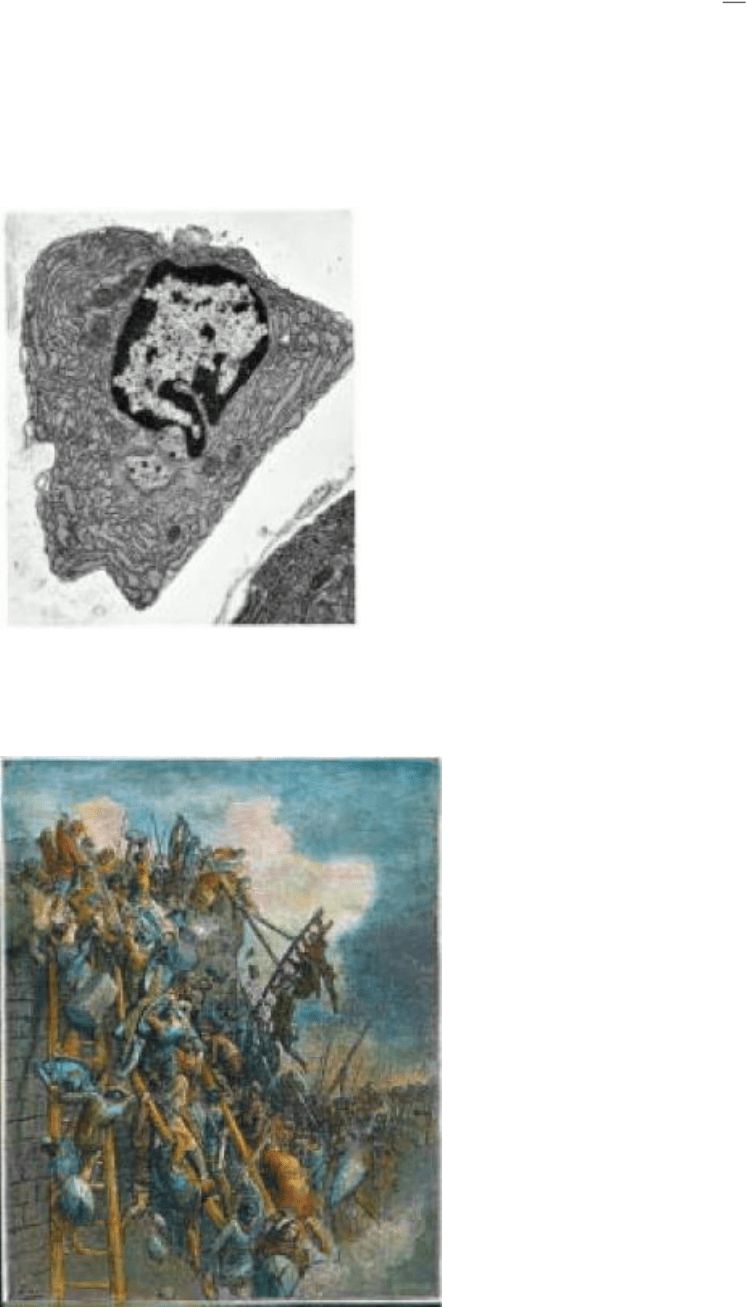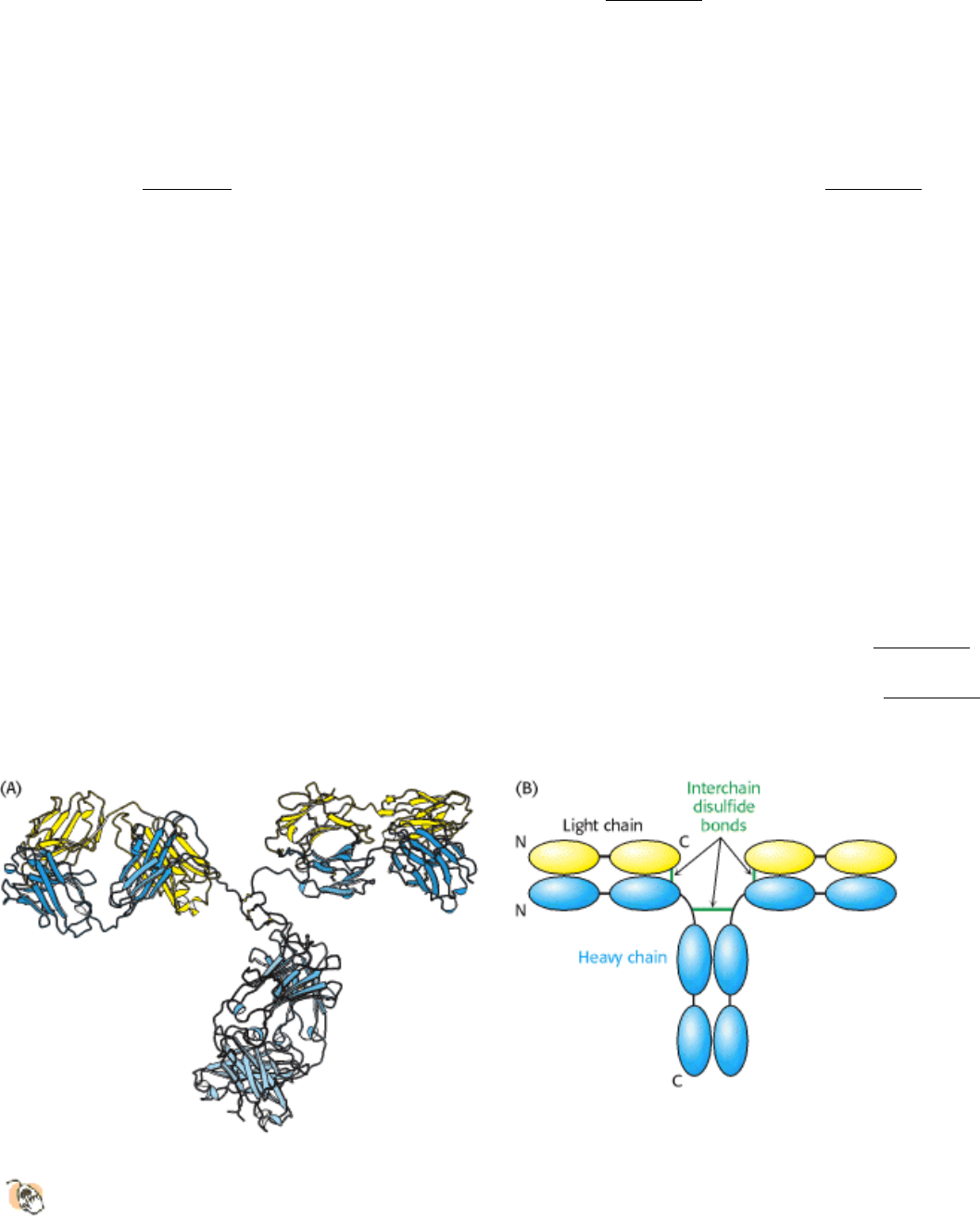Berg J.M., Tymoczko J.L., Stryer L. Biochemistry
Подождите немного. Документ загружается.

basis of its ability to bind capsaicin, the molecule responsible for the hot taste of spicy food. The capsaicin receptor, also
called VR1, functions as a cation channel that initiates a nerve impulse.
Key Terms
main olfactory epithelium
G
(olf)
functional magnetic resonance imaging (fMRI)
gustducin
amiloride-sensitive sodium channel
metabotrophic glutamate receptor
rod
cone
rhodopsin
opsin
retinal
chromophore
transducin
cGMP phosphodiesterase
cGMP-gated calcium channel
rhodopsin kinase
arrestin
guanylate cyclase
hair cell
stereocilium
tip link
nociceptor
capsaicin receptor

IV. Responding to Environmental Changes 32. Sensory Systems
Problems
1.
Of mice and rats. As noted in Section 32.1.2, one of the first odorant receptors to be matched with its ligand was a
rat receptor that responded best to n-octanal. The sequence of the corresponding mouse receptor differed from the rat
receptor at 15 positions. Surprisingly, the mouse receptor was found to respond best to n-heptanal rather than n-
octanal. The substitution of isoleucine at position 206 in the mouse for valine at this position in the rat receptor was
found to be important in determining the specificity for n-heptanal. Propose an explanation.
See answer
2.
Olfaction in worms. Unlike the olfactory neurons in the mammalian systems discussed herein, olfactory neurons in
the nematode C. elegans express multiple olfactory receptors. In particular, one neuron (called AWA) expresses
receptors for compounds to which the nematode is attracted, whereas a different neuron (called AWB) expresses
receptors for compounds that the nematode avoids. Suppose that a transgenic nematode is generated such that one of
the receptors for an attractant is expressed in AWB rather than AWA. What behavior would you expect in the
presence of the corresponding attractant?
See answer
3.
Odorant matching. A mixture of two of the compounds illustrated in Figure 32.6 is applied to a section of olfactory
epithelium. Only receptors 3, 5, 9, 12, and 13 are activated, according to Figure 32.7. Identify the likely compounds
in the mixture.
See answer
4.
Timing. Compare the aspects of taste (bitter, sweet, salty, sour) in regard to their potential for rapid time resolution.
See answer
5.
Two ears. Our ability to determine the direction from which a sound is coming is partly based on the difference in
time at which our two ears detect the sound. Given the speed of sound (350 meter/second) and the separation
between our ears (0.15 meter), what difference is expected in the times at which a sound arrives at our two ears?
How does this difference compare with the time resolution of the human hearing system? Would a sensory system
that utilized 7TM receptors and G proteins be capable of adequate time resolution?
See answer
6.
Constitutive mutants. What effect within the olfactory system would you expect for a mutant in which adenylate
cyclase is always fully active? What effect within the visual system would you expect for a mutant in which
guanylate cyclase is always fully active?
See answer
7.
Bottle choice. A widely used method for quantitatively monitoring rodent behavior with regard to taste is the bottle-
choice assay. An animal is placed in a cage with two water bottles, one of which contains a potential tastant. After a
fixed period of time (24
48 hours), the amount of water remaining in each bottle is measured. Suppose that much
less water remains in the bottle with the tastant after 48 hours. Do you suspect the tastant to be sweet or bitter?
See answer

8.
It's better to be bitter. Some nontoxic plants taste very bitter to us. Suggest one or more explanations.
See answer
9.
Unexpected consequences. Sildenafil (Viagra) is a drug widely used to treat male impotence. Sildenafil exerts its
effect by inhibiting a cGMP phosphodiesterase isozyme (PDE5) that is especially prevalent in smooth muscle.
Interestingly, certain airlines restrict pilots from flying for 24 hours after using sildenafil. Suggest a reason for this
restriction.
See answer
Chapter Integration Problem
10.
Energy and information. The transmission of sensory information requires the input of free energy. For each
sensory system (olfaction, gustation, vision, hearing, and touch), identify mechanisms for the input of free energy
that allow the transmission of sensory information.
See answer
Mechanism Problem
11.
Schiff-base formation. Propose a mechanism for the reaction between opsin and 11-cis-retinal.
See answer
Media Problems
12.
Homologous proteins, analogous binding? Odorants bind to 7TM receptors, but where they bind (and
whether all bind in the same way) is unclear. Odorants might, for example, bind on the extracellular surface,
or, like retinal, they might bind in the interior of the transmembrane region. Problem 1 of this chapter presents
evidence for the direct involvement of residue 206 in odorant binding in receptors from mouse and rat. While these
receptors' structures are not known in detail, their sequences are similar enough to rhodopsin's that the rhodopsin
structure can be used to infer the approximate location of residue 206. To see the likely location, look in the
Structural Insights module on rhodopsin. Where do you think the mouse and rat receptors bind their odorants?
13.
Deodorant? A cAMP phosphodiesterase has been discovered that is found predominantly in olfactory sensory
neurons (Yan et al., 1995, Proc. Natl. Acad. Sci. 10:9677). The enzyme is activated by Ca
2+
. What do you think
this enzyme does, and why do you think it is regulated by calcium? (Hint: Study the response and recovery
animations in the Conceptual Insights module on signaling pathways.)

IV. Responding to Environmental Changes 32. Sensory Systems
Selected Readings
Where to start
R. Axel. 1995. The molecular logic of smell Sci. Am. 273: (4) 154-159. (PubMed)
C. Dulac. 2000. The physiology of taste, vintage 2000 Cell 100: 607-610. (PubMed)
L. Stryer. 1996. Vision: From photon to perception Proc. Natl. Acad. Sci. U. S. A. 93: 557-559. (PubMed) (Full Text in
PMC)
A.J. Hudspeth. 1989. How the ear's works work Nature 341: 397-404. (PubMed)
Olfaction
L. Buck and R. Axel. 1991. A novel multigene family may encode odorant receptors: A molecular basis for odor
recognition Cell 65: 175-187. (PubMed)
B. Malnic, J. Hirono, T. Sato, and L.B. Buck. 1999. Combinatorial receptor codes for odors Cell 96: 713-723. (PubMed)
P. Mombaerts, F. Wang, C. Dulac, S.K. Chao, A. Nemes, M. Mendel-sohn, J. Edmondson, and R. Axel. 1996.
Visualizing an olfactory sensory map Cell 87: 675-686. (PubMed)
P. Mombaerts. 1999. Molecular biology of odorant receptors in vertebrates Annu. Rev. Neurosci. 22: 487-509. (PubMed)
L. Belluscio, G.H. Gold, A. Nemes, and R. Axel. 1998. Mice deficient in G(olf) are anosmic Neuron 20: 69-81.
(PubMed)
L.B. Vosshall, A.M. Wong, and R. Axel. 2000. An olfactory sensory map in the fly brain Cell 102: 147-159. (PubMed)
Taste
M.S. Herness and T.A. Gilbertson. 1999. Cellular mechanisms of taste transduction Annu. Rev. Physiol. 61: 873-900.
(PubMed)
E. Adler, M.A. Hoon, K.L. Mueller, J. Chandrashekar, N.J. Ryba, and C.S. Zuker. 2000. A novel family of mammalian
taste receptors Cell 100: 693-702. (PubMed)
J. Chandrashekar, K.L. Mueller, M.A. Hoon, E. Adler, L. Feng, W. Guo, C.S. Zuker, and N.J. Ryba. 2000. T2Rs
function as bitter taste receptors Cell 100: 703-711. (PubMed)
I. Mano and M. Driscoll. 1999. DEG/ENaC channels: A touchy superfamily that watches its salt Bioessays 21: 568-578.
(PubMed)
D.J. Benos and B.A. Stanton. 1999. Functional domains within the degenerin/epithelial sodium channel (Deg/ENaC)
superfamily of ion channels J. Physiol. (Lond.) 520: (part 3) 631-644. (PubMed)
S.K. McLaughlin, P.J. McKinnon, and R.F. Margolskee. 1992. Gustducin is a taste-cell-specific G protein closely related
to the transducins Nature 357: 563-569. (PubMed)
N. Chaudhari, A.M. Landin, and S.D. Roper. 2000. A metabotropic glutamate receptor variant functions as a taste
receptor Nat. Neurosci. 3: 113-119. (PubMed)
Vision

L. Stryer. 1988. Molecular basis of visual excitation Cold Spring Harbor Symp. Quant. Biol. 53: 283-294. (PubMed)
G. Wald. 1968. The molecular basis of visual excitation Nature 219: 800-807. (PubMed)
J.B. Ames, A.M. Dizhoor, M. Ikura, K. Palczewski, and L. Stryer. 1999. Three-dimensional structure of guanylyl cyclase
activating protein-2, a calcium-sensitive modulator of photoreceptor guanylyl cyclases J. Biol. Chem. 274: 19329-19337.
(PubMed)
J. Nathans. 1994. In the eye of the beholder: Visual pigments and inherited variation in human vision Cell 78: 357-360.
(PubMed)
J. Nathans. 1999. The evolution and physiology of human color vision: Insights from molecular genetic studies of visual
pigments Neuron 24: 299-312. (PubMed)
K. Palczewski, T. Kumasaka, T. Hori, C.A. Behnke, H. Motoshima, B.A. Fox, I. LeTrong, D.C. Teller, T. Okada, R.E.
Stenkamp, M. Yamamoto, and M. Miyano. 2000. Crystal structure of rhodopsin: A G protein-coupled receptor Science
289: 739-745. (PubMed)
Hearing
A.J. Hudspeth. 1997. How hearing happens Neuron 19: 947-950. (PubMed)
J.O. Pickles and D.P. Corey. 1992. Mechanoelectrical transduction by hair cells Trends Neurosci. 15: 254-259.
(PubMed)
R.G. Walker, A.T. Willingham, and C.S. Zuker. 2000. A Drosophila mechanosensory transduction channel Science 287:
2229-2234. (PubMed)
Touch and pain reception
A. Franco-Obregon and D.E. Clapham. 1998. Touch channels sense blood pressure Neuron 21: 1224-1226. (PubMed)
M.J. Caterina, M.A. Schumacher, M. Tominaga, T.A. Rosen, J.D. Levine, and D. Julius. 1997. The capsaicin receptor: A
heat-activated ion channel in the pain pathway Nature 389: 816-824. (PubMed)
M. Tominaga, M.J. Caterina, A.B. Malmberg, T.A. Rosen, H. Gilbert, K. Skinner, B.E. Raumann, A.I. Basbaum, and D.
Julius. 1998. The cloned capsaicin receptor integrates multiple pain-producing stimuli Neuron 21: 531-543. (PubMed)
M.J. Caterina and D. Julius. 1999. Sense and specificity: A molecular identity for nociceptors Curr. Opin. Neurobiol. 9:
525-530. (PubMed)
Other sensory systems
R.B. Frankel. 1984. Magnetic guidance of organisms Annu. Rev. Biophys. Bioeng. 13: 85-103. (PubMed)
J.L. Kirschvink, A. Kobayashi-Kirschvink, and B.J. Woodford. 1992. Magnetite biomineralization in the human brain
Proc. Natl. Acad. Sci. U. S. A. 89: 7683-7687. (PubMed) (Full Text in PMC)
C. Dulac and R. Axel. 1995. A novel family of genes encoding putative pheromone receptors in mammals Cell 83: 195-
206. (PubMed)

IV. Responding to Environmental Changes
33. The Immune System
Dedicated to the memory of Don Wiley, a pioneer in unraveling the structural basis of immune-system function
We are constantly exposed to an incredible diversity of bacteria, viruses, and parasites, many of which would flourish in
our cells or extracellular fluids were it not for our immune system. Remarkably, we are often even able to defend
ourselves against organisms that we have never before encountered. How does the immune system protect us? The key is
our ability to produce more than 10
8
distinct antibodies and more than 10
12
T-cell receptors, each of which presents a
different surface for specifically binding a molecule from a foreign organism and initiating the destruction of the invader.
The presence of this remarkable repertoire of defensive molecules poses a challenge. What prevents the immune system
from attacking cells that express molecules normally present in our bodies; that is, how does the immune system
distinguish between nonself and self? We shall examine these questions, focusing first on the structures of the proteins
participating in the molecular recognition processes and then on the mechanisms for selecting cells that express
molecules useful for protecting us from a specific pathogen. Emphasis will be on the modular construction of the
proteins of the immune system
identifying structural motifs and considering how spectacular diversity can arise from
modular construction.
33.0.1. The Immune System Adapts, Using the Principles of Evolution
The immune system comprises two parallel but interrelated systems. In the humoral immune response, soluble proteins
called antibodies (immunoglobulins) function as recognition elements that bind to foreign molecules and serve as
markers signaling foreign invasion (Figure 33.1). Antibodies are secreted by plasma cells, which are derived from B
lymphocytes (B cells). A foreign macromolecule that binds selectively to an antibody is called an antigen. In a
physiological context, if the binding of the foreign molecule stimulates an immune response, that molecule is called an
immunogen. The specific affinity of an antibody is not for the entire macromolecular antigen but for a particular site on
the antigen called the epitope or antigenic determinant.
In the cellular immune response, cells called cytotoxic T lymphocytes (also commonly called killer T cells) kill cells that
display foreign motifs on their surfaces. Another class of T cells called helper T lymphocytes contributes to both the
humoral and the cellular immune responses by stimulating the differentiation and proliferation of appropriate B cells and
cytotoxic T cells. The celluar immune response is mediated by specific receptors that are expressed on the surfaces of the
T cells.
The remarkable ability of the immune system to adapt to an essentially limitless set of potential pathogens requires a
powerful system for transforming the immune cells and molecules present in our systems in response to the presence of
pathogens. This adaptive system operates through the principles of evolution, including reproduction with variation
followed by selection of the most well suited members of a population.
If the human genome contains, by the latest estimates, only 40,000 genes, how can the immune system generate more
than 10
8
different antibody proteins and 10
12
T-cell receptors? The answer is found in a novel mechanism for generating
a highly diverse set of genes from a limited set of genetic building blocks. Linking different sets of DNA regions in a
combinatorial manner produces many distinct protein-encoding genes that are not present in the genome. A rigorous
selection process then leaves for proliferation only cells that synthesize proteins determined to be useful in the immune
response. The subsequent reproduction of these cells without additional recombination serves to enrich the cell
population with members expressing a particular protein species.
Critical to the development of the immune response is the selection process, which determines which cells will
reproduce. The process comprises several stages. In the early stages of the development of an immune response, cells
expressing molecules that bind tightly to self-molecules are destroyed or silenced, whereas cells expressing molecules

that do not bind strongly to self-molecules and that have the potential for binding strongly to foreign molecules are
preserved. The appearance of an immunogenic invader at a later time will stimulate cells expressing immunoglobulins or
T-cell receptors that bind specifically to elements of that pathogen to reproduce in evolutionary terms, such cells are
selected for. Thus, the immune response is based on the selection of cells expressing molecules that are specifically
effective against a particular invader; the response evolves from a population with wide-ranging specificities to a more-
focused collection of cells and molecules that are well suited to defend the host when confronted with that particular
challenge.
IV. Responding to Environmental Changes 33. The Immune System
Figure 33.1. Immunoglobulin Production. An electron micrograph of a plasma cell shows the highly developed rough
endoplasmic reticulum necessary for antibody secretion. [Courtesy of Lynne Mercer.]
IV. Responding to Environmental Changes 33. The Immune System

Just as Medieval defenders used their weapons and the castle walls to defend their city, the immune system
constantly battles against foreign invaders such as viruses, bacteria, and parasites to defend the organism.
Antibody molecules provide a key element in the immune system's defensive arsenal. For example, specific antibodies
can bind to molecules on the surfaces of viruses and prevent the viruses from infecting cells. Above, an antibody binds to
one subunit on hemagglutinin from the surface of influenza virus. [(Left) The Granger Collection.]
IV. Responding to Environmental Changes 33. The Immune System
33.1. Antibodies Possess Distinct Antigen-Binding and Effector Units
Antibodies are central molecular players in the immune response, and we examine them first. A fruitful approach in
studying proteins as large as antibodies is to split the protein into fragments that retain activity. In 1959, Rodney Porter
showed that immunoglobulin G (IgG), the major antibody in serum, can be cleaved into three 50-kd fragments by the
limited proteolytic action of papain. Two of these fragments bind antigen. They are called F
ab
(F stands for fragment, ab
for antigen binding). The other fragment, called F
c
because it crystallizes readily, does not bind antigen, but it has other
important biological activities, including the mediation of responses termed effector functions. These functions include
the initiation of the complement cascade, a process that leads to the lysis of target cells. Although such effector functions
are crucial to the functioning of the immune system, they will not be discussed further here.
How do these fragments relate to the three-dimensional structure of whole IgG molecules? Immunoglobulin G consists
of two kinds of polypeptide chains, a 25-kd light (L) chain and a 50-kd heavy (H) chain (Figure 33.2). The subunit
composition is L
2
H
2
. Each L chain is linked to an H chain by a disulfide bond, and the H chains are linked to each other
by at least one disulfide bond. Examination of the amino acid sequences and three-dimensional structures of IgG
molecules reveals that each L chain comprises two homologous domains, termed immunoglobulin do-mains, to be
described in detail in Section 33.2. Each H chain has four immunoglobulin domains. Overall, the molecule adopts a
conformation that resembles the letter Y, in which the stem, corresponding to the F
c
fragment obtained by cleavage with
papain, consists of the two carboxyl-terminal immunoglobulin domains of each H chain and in which the two arms of the
Y, corresponding to the two F
ab
fragments, are formed by the two amino-terminal domains of each H chain and the two
amino-terminal domains of each L chain. The linkers between the stem and the two arms consist of relatively extended
polypeptide regions within the H chains and are quite flexible.
Papain cleaves the H chains on the carboxyl-terminal side of the disulfide bond that links each L and H chain (Figure
33.3). Thus, each F
ab
consists of an entire L chain and the amino-terminal half of an H chain, whereas F
c
consists of the
carboxyl-terminal halves of both H chains. Each F
ab
contains a single antigen-binding site. Because an intact IgG
molecule contains two F
ab
components and therefore has two binding sites, it can cross-link multiple antigens (Figure
33.4). Furthermore, the F
c
and the two F
ab
units of the intact IgG are joined by flexible polypeptide regions that allow

facile variation in the angle between the F
ab
units through a wide range (Figure 33.5). This kind of mobility, called
segmental flexibility, can enhance the formation of an antibody-antigen complex by enabling both combining sites on an
antibody to bind an antigen that possesses multiple binding sites, such as a viral coat composed of repeating identical
monomers or a bacterial cell surface. The combining sites at the tips of the F
ab
units simply move to match the distance
between specific determinants on the antigen.
Immunoglobulin G is the antibody present in highest concentration in the serum, but other classes of immunoglobulin
also are present (Table 33.1). Each class includes an L chain (either κ or λ) and a distinct H chain (Figure 33.6). The
heavy chains in IgG are called γ chains, whereas those in immunoglobulins A, M, D, and E are called α, µ, δ, and ε,
respectively. Immunoglobulin M (IgM) is the first class of antibody to appear in the serum after exposure to an antigen.
The presence of 10 combining sites enables IgM to bind especially tightly to antigens containing multiple identical
epitopes. The strength of an interaction comprising multiple independent binding interactions between partners is termed
avidity rather than affinity, which denotes the binding strength of a single combining site. The presence of 10 combining
sites in IgM compared with 2 sites in IgG enables IgM to bind many multivalent antigens that would slip away from IgG.
Immunoglobulin A (IgA) is the major class of antibody in external secretions, such as saliva, tears, bronchial mucus, and
intestinal mucus. Thus, IgA serves as a first line of defense against bacterial and viral antigens. The role of
immunoglobulin D (IgD) is not yet known. Immunoglobulin E (IgE) is important in conferring protection against
parasites, but IgE also causes allergic reactions. IgE-antigen complexes form cross-links with receptors on the surfaces
of mast cells to trigger a cascade that leads to the release of granules containing pharmacologically active molecules.
Histamine, one of the agents released, induces smooth muscle contraction and stimulates the secretion of mucus.
A comparison of the amino acid sequences of different IgG antibodies from human beings or mice shows that the
carboxyl-terminal half of the L chains and the carboxyl-terminal three-quarters of the H chains are very similar in all of
the antibodies. Importantly, the amino-terminal domain of each chain is more variable, including three stretches of
approximately 7 to 12 amino acids within each chain that are hypervariable, as shown for the H chain in Figure 33.7. The
amino-terminal immunglobulin domain of each chain is thus referred to as the variable region, whereas the remaining
immunoglobulin domains are much more similar in all antibodies and are referred to as constant regions (Figure 33.8).
IV. Responding to Environmental Changes 33. The Immune System 33.1. Antibodies Possess Distinct Antigen-Binding and Effector Units
Figure 33.2. Immunoglobulin G Structure.
(A) The three-dimensional structure of an IgG molecule showing the light
chains in yellow and the heavy chains in blue. (B) A schematic view of an IgG molecule indicating the positions
of the interchain disulfide bonds. N, amino terminus; C, carboxyl terminus.

IV. Responding to Environmental Changes 33. The Immune System 33.1. Antibodies Possess Distinct Antigen-Binding and Effector Units
Figure 33.3. Immunoglobulin G Cleavage. Treatment of intact IgG molecules with the protease papain results in the
formation of three large fragments: two F
ab
fragments that retain antigen-binding capability and one F
c
fragment that
does not.
IV. Responding to Environmental Changes 33. The Immune System 33.1. Antibodies Possess Distinct Antigen-Binding and Effector Units
Figure 33.4. Antigen Cross-Linking. Because IgG molecules include two antigen-binding sites, antibodies can cross-
link multivalent antigens such as viral surfaces.
